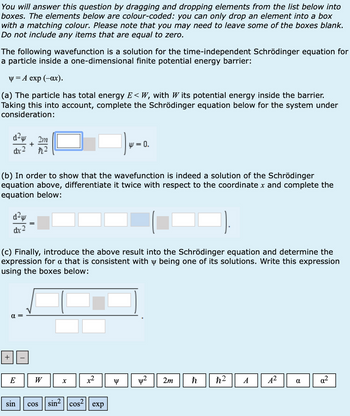
College Physics
11th Edition
ISBN: 9781305952300
Author: Raymond A. Serway, Chris Vuille
Publisher: Cengage Learning
expand_more
expand_more
format_list_bulleted
Question

Transcribed Image Text:You will answer this question by dragging and dropping elements from the list below into
boxes. The elements below are colour-coded: you can only drop an element into a box
with a matching colour. Please note that you may need to leave some of the boxes blank.
Do not include any items that are equal to zero.
The following wavefunction is a solution for the time-independent Schrödinger equation for
a particle inside a one-dimensional finite potential energy barrier:
y=A exp (-ax).
(a) The particle has total energy E<W, with W its potential energy inside the barrier.
Taking this into account, complete the Schrödinger equation below for the system under
consideration:
d²w 2m
dx-2
+
たこ
W = 0.
(b) In order to show that the wavefunction is indeed a solution of the Schrödinger
equation above, differentiate it twice with respect to the coordinate x and complete the
equation below:
dx
(c) Finally, introduce the above result into the Schrödinger equation and determine the
expression for a that is consistent with y being one of its solutions. Write this expression
using the boxes below:
+
α
E
W
x
sin
COS
sin2 cos² exp
Y
2m
h
h2
A
A²
α
d
Expert Solution
This question has been solved!
Explore an expertly crafted, step-by-step solution for a thorough understanding of key concepts.
Step by stepSolved in 2 steps

Knowledge Booster
Similar questions
- There is an electron, in a 1-d, infinitely deep square potential well with a width of d. If it is in ground state, 1. Draw the electron's wavefunction. Show the position of the walls of the potential well. 2. Explain how the probability distribution for detecting the electron at a given position differs from the wavefunction.arrow_forwardWe will consider the Schrödinger equation in this problem as well as the analogies between the wavefunction and how boundary conditions are an essential part of developing this equation for various problems (situations). a) Write the form of the time-independent Schrödinger equation if the potential is that of a spring with spring constant k. Write the form of the time-dependent Schrödinger equation with the same potential. Briefly describe all the terms and variables in these equations. b) One solution to the time independent Schrödinger equation has the form Asin(kx). Why might it be called the wavefunction? If this form represents a wave of light, what is the energy for one photon? (Notek here stands for the wavevector and not the spring constant.) c) Why must all wavefunctions go to zero at infinite distance from the center of the coordinate system in all systems where the potential energy is always finite?arrow_forwardQuestion A3 Consider the energy eigenstates of a particle in a quantum harmonic oscillator with frequency w. a) Write down expressions for the energies of the three lowest states. b) c) Sketch the potential for this system, along with the position of the three lowest energy levels. Add to your sketch the form of the wavefunction and the probability density in the three lowest energy states. [10 marks]arrow_forward
- Consider a finite potential step with V = V0 in the region x < 0, and V = 0 in the region x > 0 (image). For particles with energy E > V0, and coming into the system from the left, what would be the wavefunction used to describe the “transmitted” particles and the wavefunction used to describe the “reflected” particles?arrow_forwardA particle of mass m is confined within a finite square well of depth V0 and width L.Sketch this potential, together with the form of the wavefunction and probability density for a particle in the lowest energy state. Briefly outline the procedure you would follow to determine the total number of energy eigenstates that can exist within a given finite square well.arrow_forwardAn electron is confined to a 1-dimensional infinite potential well of dimensions 1.55 nm. Find the energy of the ground state of the electron. Give your answer in units of electron volts (eV). Round your answer to 2 decimal places. Add your answerarrow_forward
arrow_back_ios
arrow_forward_ios
Recommended textbooks for you
 College PhysicsPhysicsISBN:9781305952300Author:Raymond A. Serway, Chris VuillePublisher:Cengage Learning
College PhysicsPhysicsISBN:9781305952300Author:Raymond A. Serway, Chris VuillePublisher:Cengage Learning University Physics (14th Edition)PhysicsISBN:9780133969290Author:Hugh D. Young, Roger A. FreedmanPublisher:PEARSON
University Physics (14th Edition)PhysicsISBN:9780133969290Author:Hugh D. Young, Roger A. FreedmanPublisher:PEARSON Introduction To Quantum MechanicsPhysicsISBN:9781107189638Author:Griffiths, David J., Schroeter, Darrell F.Publisher:Cambridge University Press
Introduction To Quantum MechanicsPhysicsISBN:9781107189638Author:Griffiths, David J., Schroeter, Darrell F.Publisher:Cambridge University Press Physics for Scientists and EngineersPhysicsISBN:9781337553278Author:Raymond A. Serway, John W. JewettPublisher:Cengage Learning
Physics for Scientists and EngineersPhysicsISBN:9781337553278Author:Raymond A. Serway, John W. JewettPublisher:Cengage Learning Lecture- Tutorials for Introductory AstronomyPhysicsISBN:9780321820464Author:Edward E. Prather, Tim P. Slater, Jeff P. Adams, Gina BrissendenPublisher:Addison-Wesley
Lecture- Tutorials for Introductory AstronomyPhysicsISBN:9780321820464Author:Edward E. Prather, Tim P. Slater, Jeff P. Adams, Gina BrissendenPublisher:Addison-Wesley College Physics: A Strategic Approach (4th Editio...PhysicsISBN:9780134609034Author:Randall D. Knight (Professor Emeritus), Brian Jones, Stuart FieldPublisher:PEARSON
College Physics: A Strategic Approach (4th Editio...PhysicsISBN:9780134609034Author:Randall D. Knight (Professor Emeritus), Brian Jones, Stuart FieldPublisher:PEARSON

College Physics
Physics
ISBN:9781305952300
Author:Raymond A. Serway, Chris Vuille
Publisher:Cengage Learning

University Physics (14th Edition)
Physics
ISBN:9780133969290
Author:Hugh D. Young, Roger A. Freedman
Publisher:PEARSON

Introduction To Quantum Mechanics
Physics
ISBN:9781107189638
Author:Griffiths, David J., Schroeter, Darrell F.
Publisher:Cambridge University Press

Physics for Scientists and Engineers
Physics
ISBN:9781337553278
Author:Raymond A. Serway, John W. Jewett
Publisher:Cengage Learning

Lecture- Tutorials for Introductory Astronomy
Physics
ISBN:9780321820464
Author:Edward E. Prather, Tim P. Slater, Jeff P. Adams, Gina Brissenden
Publisher:Addison-Wesley

College Physics: A Strategic Approach (4th Editio...
Physics
ISBN:9780134609034
Author:Randall D. Knight (Professor Emeritus), Brian Jones, Stuart Field
Publisher:PEARSON